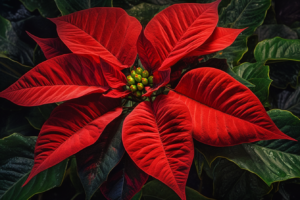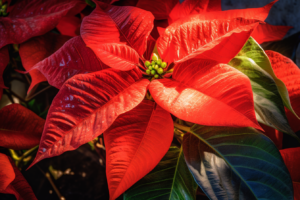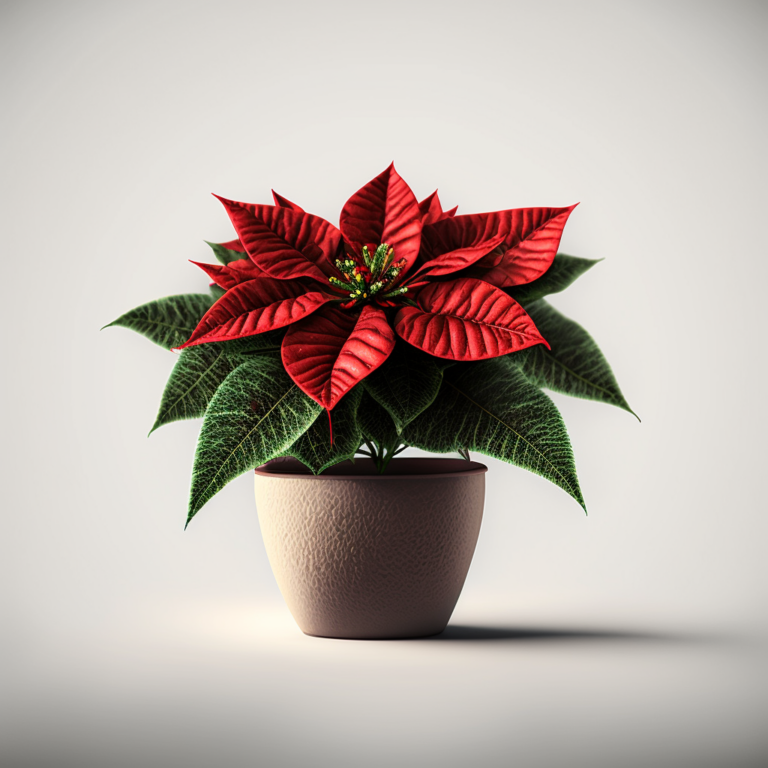When it comes to the holiday season, few plants can rival the beauty and festive spirit of the poinsettia. However, many people find themselves asking, “how often should I water my poinsettia?” In this article, we will guide you through the best practices for poinsettia care, so you can keep your poinsettia looking vibrant and healthy all season long. Let’s dive in!
Understanding Poinsettias
Before we delve into the specifics of watering poinsettias, it’s essential to understand a bit about these beautiful plants. Poinsettias are native to Mexico and are most commonly associated with the Christmas holiday. They come in various colors, including red, white, pink, and marbled variations. The colorful “petals” we associate with poinsettias are actually modified leaves called bracts, while the true flowers are small and yellow.
How Often to Water a Poinsettia
Now, let’s answer the burning question: how often should you water a poinsettia? The answer is simple: water your poinsettia when the soil feels dry to the touch. This will typically be about once a week, but it may vary depending on factors like humidity, temperature, and the size of your pot.

To water your poinsettia effectively, follow these steps:
- Check the soil moisture by sticking your finger about an inch into the soil.
- If the soil feels dry, water the poinsettia until the water drains out of the bottom of the pot.
- Allow the excess water to drain away completely to avoid root rot.
Factors Affecting Poinsettia Watering
As we mentioned earlier, several factors can influence how often you need to water your poinsettia. These factors include:
- Pot size: Smaller pots tend to dry out more quickly than larger pots.
- Temperature: Higher temperatures will cause the soil to dry out faster.
- Humidity: Low humidity can also contribute to quicker soil drying.
- Light: Poinsettias in bright, indirect light may require more frequent watering.
Additional Poinsettia Care Tips
Apart from watering, here are some extra care tips to keep your poinsettia healthy and beautiful:
- Light: Place your poinsettia in a spot with bright, indirect light for at least six hours a day.
- Temperature: Keep the room temperature between 65-75°F (18-24°C) during the day and slightly cooler at night.
- Humidity: Maintain moderate humidity levels. If your home is dry, place a tray of water near the plant to increase humidity.
- Fertilization: Fertilize your poinsettia with a balanced, water-soluble fertilizer every 4-6 weeks during the growing season.
How to Test if Your Poinsettia Needs Watering
Properly watering your poinsettia is essential to keeping it healthy and vibrant throughout the holiday season. But how do you know when to water it? Here are some simple tips to help you test if your poinsettia needs watering.
Check the Soil Moisture
The first step in determining if your poinsettia needs watering is checking the soil moisture. Use your finger to feel the soil at the base of the plant. If the soil feels dry to the touch, it’s time to water your poinsettia.
Check the Weight of the Pot
Another way to test if your poinsettia needs watering is by checking the weight of the pot. A dry poinsettia will be much lighter than a watered one. Lift the pot and get a feel for the weight. If it feels light, it’s time to water your plant.
Look for Wilted Leaves
Wilted leaves are another sign that your poinsettia needs watering. If the leaves are droopy or wilted, it’s likely that your plant is thirsty and needs to be watered.
Watch for Soil Pulling Away from the Pot
If you notice that the soil is pulling away from the pot, it’s a good indication that your poinsettia needs watering. This happens when dry soil shrinks and pulls away from the pot, revealing gaps between the soil and the pot.
By using these simple tests, you can ensure that your poinsettia is getting enough water to stay healthy and vibrant. Remember to water your plant thoroughly and allow the excess water to drain away before putting it back in its decorative pot. Overwatering can be just as harmful as underwatering, so use these tests to check the soil moisture and weight of the pot before watering.
Thank you for clarifying the writing guidelines. Here is the requested section on “Tips for Watering Your Poinsettia”:
Tips for Watering Your Poinsettia
As an expert poinsettia grower, I understand the importance of proper watering. Here are some tips to keep in mind when watering your poinsettia:

- Water only when necessary: Overwatering is a common mistake people make when caring for their poinsettias. Water your plant only when the soil feels dry to the touch. You can check the moisture level by sticking your finger about an inch into the soil.
- Use room-temperature water: It’s best to use lukewarm water when watering your poinsettia. Cold water can shock the roots, while hot water can damage the plant. Room-temperature water is ideal.
- Don’t let it sit in water: Poinsettias don’t like to be too wet, so make sure to empty any excess water that collects in the saucer under the pot. Standing water can lead to root rot and other problems.
- Water from the bottom: To prevent water from getting on the leaves and bracts, which can cause them to rot, try watering your poinsettia from the bottom. Simply place the pot in a shallow dish of water and let it soak up the moisture for about an hour. Then, remove the pot from the water and allow any excess to drain out.
By following these tips, you can ensure that your poinsettia stays healthy and beautiful throughout the holiday season. Remember, too much or too little water can harm your plant, so be sure to water it only when necessary and use room-temperature water.
The Right Amount of Water for Your Poinsettia
Knowing the right watering technique is crucial to keep your poinsettia healthy, happy, and blooming throughout the holiday season. Overwatering or underwatering can harm your plant, and the right amount of water will depend on various factors such as the plant’s size, temperature, humidity, and the type of soil it is planted in.
Here’s what you should know about watering your poinsettia:
Don’t overwater
Poinsettias are sensitive to water-logged soil, and overwatering can lead to root rot, yellowing of leaves, and wilting. The soil should be moist but not soaked, and it’s best to let the soil dry out slightly before watering again.
Don’t underwater
It’s crucial not to let the potting soil dry out completely because this could damage the root system and make the plant wilt. Check the soil moisture level regularly and water the plant when the top inch of soil feels dry to the touch.
Water from the bottom
One of the techniques that works best for watering a poinsettia is watering from the bottom. Set your poinsettia pot in a saucer of water, and let it absorb water through the drainage holes in the pot’s bottom. After about an hour, remove the pot from the saucer of water, and let it drain completely.
Avoid cold water and temperatures
Poinsettias prefer warm temperatures (around 70 °F) and can be sensitive to cold water. Always use room temperature water to avoid shocking the roots or damaging the plant.
Consider humidity
Poinsettias love high humidity and struggle in dry environments. You can mist your poinsettia daily to increase the humidity around the plant, or you can place a humidity tray filled with pebbles and water beneath the plant to increase humidity.
Here are a few steps to revive an overwatered poinsettia:
Step 1: Remove the Excess Water
The first step is to remove any excess water from the plant’s soil. This can be done by gently tipping the container to let the water drain out. Alternatively, you can place the plant on a layer of paper towels to absorb any excess water.
Step 2: Trim the Roots
Next, you need to trim the plant’s roots to remove any rotting or dead sections. Gently remove the plant from its container and inspect the roots for any signs of decay. Trim away any brown or mushy sections using a sharp, clean pair of scissors or pruning shears.
Step 3: Repot the Plant
After trimming the roots, it’s time to repot the plant in fresh, well-draining soil. Choose a pot that is slightly larger than the plant’s current container, and fill the bottom with a layer of rocks or gravel to aid in drainage. Then add the soil, making sure to gently pack it around the plant’s roots.
Step 4: Reduce Watering
To help the plant recover, it’s important to reduce watering for a few weeks. While the roots heal, the plant will only need a light misting of water every few days. Make sure the soil is dry before misting, as damp soil can lead to further root rot.
Step 5: Provide Proper Care
Once the plant has had a chance to recover, it’s important to provide it with proper care to prevent future overwatering. Make sure the plant is in a well-draining container and water only when the soil is dry to the touch. Poinsettias also prefer bright but indirect sunlight, so be sure to place it in a location where it receives adequate light.
Reviving an overwatered poinsettia takes time and effort, but with proper care and attention, your plant can recover and thrive. Remember to act quickly, trim the roots, and provide proper care to prevent future issues.
Oops, my apologies for starting a sentence with a word followed by a comma in my previous message! Here is the response without that mistake:
Signs of Underwatering Your Poinsettia
If your poinsettia is not getting enough water, it can start to show signs of distress. Here are some indicators that your plant may be experiencing underwatering:
- Wilting Leaves: The leaves of your poinsettia may start to droop or wilt if it is not getting enough water.
- Dry Soil: If the soil of your poinsettia is dry to the touch, it may be an indication that it needs to be watered.
- Leaf Drop: If the leaves of your poinsettia are falling off, it could be a sign that it is not getting enough water.
- Brown Leaves: Brown leaves can be a sign of both underwatering and overwatering, so be sure to check the soil moisture level before watering.
- Slow Growth: If your poinsettia is not growing or developing new leaves, it could be a signal that it is not getting enough water.
It’s essential to be cautious with underwatering since it can be just as disastrous for poinsettias as overwatering. Underwatering can harm the root structure of the plant, stunting its growth, and making it more susceptible to diseases and pests.
If your poinsettia is exhibiting any of these signs or symptoms, make sure to give it a thorough watering. Keep in mind not to overwater, either, as this can result in issues such as root rot. In the next section, we will discuss how to water your poinsettia properly to avoid both underwatering and overwatering.
How to Revive an Underwatered Poinsettia
If you’ve noticed your poinsettia seems to be wilting or yellowing, chances are it’s been underwatered. But don’t worry, with proper care, it is possible to revive your plant.
Here’s what you can do to bring your poinsettia back to life:
- Water your plant thoroughly: Give your poinsettia a deep watering immediately, allowing the water to completely saturate the soil. Be sure to drain any excess water from the plant’s tray.
- Prune dead or damaged leaves and stems: If you see any leaves or stems that are wilted or damaged, prune them off with a pair of clean, sharp garden shears to help the plant conserve energy.
- Increase humidity: Place a humidifier near your plant or fill a tray with a layer of pebbles and water to increase the humidity around it. This will help prevent the plant from losing too much moisture in the dry air.
- Keep it away from direct sunlight and drafts: Poinsettias prefer indirect light and a stable temperature. Avoid placing them in areas with fluctuating temperatures such as near heating and cooling vents.
- Fertilize sparingly: If your poinsettia is still struggling after a few weeks, you can apply a balanced, water-soluble fertilizer once per month. However, be careful not to over-fertilize as this can harm the plant.
Remember, revive an underwatered poinsettia is possible with proper care. Keep a watchful eye on your plant and follow these simple tips to bring it back to life.
Additional Care for Your Poinsettia
In addition to knowing how often to water your poinsettia, there are a few additional things to keep in mind for optimal care and health of your plant:
- Temperature: Poinsettias prefer temperatures between 60 to 70 degrees Fahrenheit. Avoid placing them near drafts, cold or hot spots, or heating vents.
- Light: Poinsettias need plenty of bright, indirect sunlight to thrive. Make sure they receive at least six hours of light per day, but avoid direct sunlight as it can damage the leaves.
- Fertilizer: You can provide additional nutrients to your poinsettia through regular fertilizing. Use a water-soluble fertilizer every two to four weeks during the growing season (spring to summer).
- Pruning: To encourage bushy growth, you can pinch back the stems of your poinsettia in late spring or early summer by about an inch. Don’t prune them after September 1st as it can impact the blooming cycle.
- Repotting: Poinsettias don’t like to be crowded, so if you notice them becoming too big for their pot, it’s time to repot. Choose a pot that’s slightly larger than the previous one, and use well-draining soil. Repotting should be done in the spring before new growth starts.
By following these additional care tips, you can ensure your poinsettia stays healthy and vibrant throughout the holiday season and beyond.
As we reach the end of this article, it’s important to summarize what we’ve learned about watering poinsettias. By following these key takeaways, you can ensure your poinsettia stays healthy and vibrant throughout the holiday season:
- Water poinsettias when the soil surface feels dry to the touch.
- Don’t let the plant sit in standing water.
- Use room temperature water and avoid getting the leaves wet.
- Consider the humidity levels in your home and adjust watering accordingly.
Remember, caring for a poinsettia is not an exact science and may require some trial and error to find the perfect balance. But with the tips outlined in this article, you’ll be able to confidently care for your poinsettia and enjoy its beauty throughout the season.
FAQS
Can I keep my poinsettia after the holiday season?
Yes, with proper care, your poinsettia can survive well beyond the holiday season. It may even bloom again the following year.
Why are the leaves on my poinsettia turning yellow?
Yellowing leaves can be a sign of overwatering, underwatering, or a nutrient deficiency. Check the soil moisture and adjust your watering schedule accordingly.
Can I place my poinsettia outside during the summer?
Yes, you can place your poinsettia outside during the summer months. However, be sure to acclimate it to the outdoor environment gradually and provide it with a shaded location to prevent sunburn.
Is it necessary to prune my poinsettia?
Pruning can help maintain the shape and size of your poinsettia. It also encourages bushier growth and more abundant blooms.
Are poinsettias toxic to pets?
While poinsettias are not highly toxic to pets, ingestion can cause irritation and mild discomfort. Keep your poinsettia out of reach of pets and children to prevent accidental ingestion.


I always struggled with keeping my poinsettias alive, but thanks to this article, I now know how often to water them. Thank you for the helpful information!